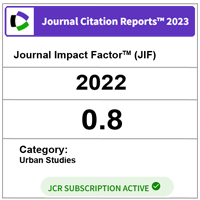Valuation of Urban Commercial Properties in Nigeria for Secured Lending: Issues and Developments
DOI:
https://doi.org/10.11113/ijbes.v5.n1.247Keywords:
Commercial Property, Secured Lending, Market Valuation, Mortgage Lending Valuation, Nigeria.Abstract
Valuation for secured lending is required when an interest in real property is used as security for a loan. The outcome of such valuation will help the lending institution to achieve commercial prudence in lending as well as avoid taking undue risk. This paper examines the issues and developments in the valuation of urban commercial properties in Nigeria for secured lending purposes. It argues that due to the volatile nature of the Nigerian economy, coupled with the linkage between the economy and commercial property markets, the maximum amount of loan to be granted by lenders in the country using interest in commercial property as collateral should be based on the Mortgage Lending Value (MLV) and not the Market Value (MV) of the property, although the market value should also be reported in the valuation. A case study is used to demonstrate the valuation. It further contends that since the inputs for determining the MLV of a commercial property must be derived from long-term trends in the property and financial markets, it is more stable than MV when used to determine the maximum amount of mortgage loan to be granted by a lender. It concludes that the stability of the MLV makes it more reliable than the MV in achieving commercial prudence in mortgage lending as it fits into the long-term nature of mortgage loan repayment.References
Ajayi, C.A. (1998). Property Investment Valuation and Analysis. Ibadan: De-Ayo Publications.
Aluko, B.T. (2007). Implications of the Current Trends in Mortgage Valuation Practice in Nigeria. International Journal of Strategic Property Management, 11, 17- 31.
Babawale, G. K. (2006). The Growing Concern over Valuation Accuracy in Nigeria. Journal of Land Use and Development Studies, 2 (1).
Baum, A. & Crosby, N. (1995). Property Investment Appraisal (2nd ed). London: International Thomson Business Press.
Blake, A. & Eves, C. (2011). Valuers‟ Liability: The Impact of Torts Reform in Queensland. Paper presented at the 17th Pacific Rim Real Estate Society Conference held at Gold Coast, Australia, January 16 – 19.
Boon, F.N. & Higgins, D. (2007). Modelling the Commercial Property Market: An Empirical Study of the Singapore Office Market. Pacific Rim Property Research Journal, 13(2), 176 – 193.
Butler, D. & Richmond, D. (1990). Advanced Valuation. London: Macmillan.
Chin, H. W. (2003). Macro-Economic Factors Affecting Office Rental Values in Southeast Asian Cities: The Case of Singapore, Hong Kong, Taipei, Kuala Lumpur and Bangkok. Paper presented at the 9th Pacific Rim Real Estate Society Conference held at Brisbane, Australia.
Crosby, N. (1987). Application of Growth Explicit Cash Flow Models to Property Investment Valuation. Conference Paper. Modern Investment Valuation Techniques. Trent Polytechnic. Nottingham. March 27.
Crosby, N. (2000).Valuation Accuracy, Variation, and Bias in the context of Standards and Expectations. Journal of Property Investment and Finance, 18(2), 130 – 161.
Crosby, N., Hughes, C. & Murdoch, J. (2004). Influences on Secured Lending Property Valuations in the UK. Paper presented at the European Real Estate Society Conference held in Milan, June 2 – 5.
Davies, E. P. & Zhu, H. (2009). Commercial Property Prices and Bank Performance. The Quarterly Review of Economics and Finance, 49, 1341 – 1359.
Doungmanee, P. (n.d). Linkages between the Property Market and the Commercial Bank Sector and their Impacts on Thai Economy.
Ekenta, C. & Iroham, C.O. (2014). Challenges of Mortgage Valuation in Port- Harcourt, Nigeria. Issues in Business Management and Economics, 2(4), 074 - 079.
Gane, D. (1995). A DCF Analysis of Market Price for Leasehold Investments. Journal of Property Valuation and Investment, 13(3), 42-52.
Hargitay, S.E & Yu, S. M. (1993). Property Investment Decisions: A Quantitative Approach. London: E & F. N. Spon.
Hui, E.C.M. & Yu, K. H. (2006). The Dynamics of Hong Kong’s Office Rental Market. International Journal of Strategic Property Management, 10,145-168.
Ifediora, G.S.A. (2000). Real Estate Valuation and Appraisal Practice for the Real Estate Industry in the New Millennium. Paper Presented at a CPD Workshop organised by the Enugu Branch of the Nigerian Institution of Estate Surveyors and Valuers at Zodiac Hotels Ltd, Enugu, June 22 – 23.
IVSC (2017). International Valuation Standards. London: The International Valuation Standards Council.
Mackmin, D. (1995). Negative Leasehold. Journal of Property Valuation and Investment, 13(4), 33-44.
McCartney, J. (2012). Short and Long-Run Rent Adjustment in the Dublin Office Market. Journal of Property Research, 29(3), 201- 226.
Millington, A. F. (1982). An Introduction to Valuation (2nd ed). London: Estates Gazette.
Odudu, W. O. (1999). Property Valuation as a Tool for Secured Credit Transactions. Journal of the Nigerian Institution of Estate Surveyors and Valuers, 23(3), 48– 52.
Ogunba, O.A. (2013). Principles and Practice of Property Valuation in Nigeria. Ibadan: Atlantis Books.
Ogunba, O.A. & Ajayi, C.A. (1998). An Assessment of the Accuracy of Valuation in the Residential Property Market in Lagos. Journal of the Nigerian Institution of Estate Surveyors and Valuers, 21(2), 9 – 17.
Okoye, C.S.O. (1985). Investment Value in a Depressed Market. Journal of the Nigerian Institution of Estate Surveyors and Valuers, 13(1), 21 – 26.
Oyetunji, A. K. & Oyetunji-Olakunmi, B. G. (2017). Assessment of Viability Appraisal Practice by Estate Surveyors and Valuers in Lagos Metropolis, Nigeria. International Journal of Built Environment and Sustainability, 4 (1), 17-22.
Ozyurt, S. (2014). Spatial Dependence in Commercial Property Prices: Micro Evidence from Netherlands. European Central Bank Working Paper Series No. 1627. January.
RICS (2017). RICS Valuation Standards (The Red Book). London: The Royal Institution of Chartered Surveyors.
RICS (1995). The Contractor‟s Basis of Valuation for Rating Purposes: A Guidance Note. London: The Royal Institution of Chartered Surveyors.
TEGoVA (2016). European Valuation Standards (The Blue Book). Brussels: The European Group of Valuers’ Associations.
Udo, G.O. (1993). Challenges in Estate Management Education. Journal of the Nigerian Institution of Estate Surveyors and Valuers, 17 (1), 16 – 20.
Udo, G.O. (2003). Model Building in Property Valuation. Enugu: Institute for Development Studies, University of Nigeria.
Udoekanem, N. B. (2012). The Relevance of Contemporary Valuation Techniques in the Determination of Buy-out Value of Leasehold Properties in Uyo, Nigeria. Built Environment Journal. 9(1): 23 - 43.
Udoekanem, N. B. (2015). Assessment of Commercial Property Rental Dynamics in Minna and Abuja. Ph.D. Thesis submitted to the Postgraduate School, Federal University of Technology, Minna, Nigeria
Wyatt, P. (2007). Property Valuation in an Economic Context. Oxford: Blackwell Publishing.
Wyatt, P. (2009). Replacement Cost and Market Value. Journal of Property Investment and Finance, 27(6), 593 – 602.
Wyatt, P. (2013). Property Valuation in an Economic Context (2nd ed). London: John Wiley & Sons.
Zhu, H. (2003). The Importance of Property Markets for Monetary Policy and Financial Stability. Bank for International Settlement Papers No. 21.
Downloads
Published
How to Cite
Issue
Section
License
Copyright of articles that appear in International Journal of Built Environment and Sustainability belongs exclusively to Penerbit Universiti Teknologi Malaysia (Penerbit UTM Press). This copyright covers the rights to reproduce the article, including reprints, electronic reproductions or any other reproductions of similar nature.
Authors who publish with this journal agree to the following terms:
- This Journal applies Creative Commons Licenses of CC-BY-NC-SA
- Authors retain copyright and grant the journal right of publication with the work simultaneously licensed under a Creative Commons Attribution License that allows others to share the work with an acknowledgement of the work's authorship and publication in this journal.
- Authors are able to enter into separate, additional contractual arrangements for the non-exclusive distribution of the journal's published version of the work (e.g., post it to an institutional repository or publish it in a book), with an acknowledgement of its publication in this journal.
- Authors are permitted and encouraged to post their work online (e.g., in institutional repositories or on their website) prior to and during the submission process, as it can lead to productive exchanges, as well as earlier and greater citation of published work (See The Effect of Open Access).







